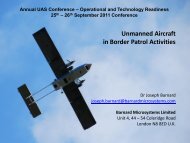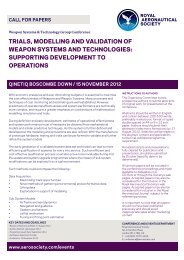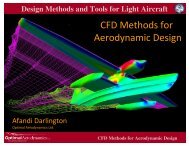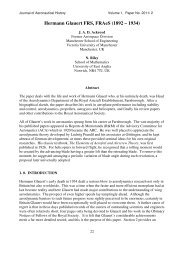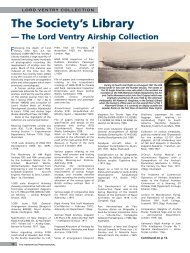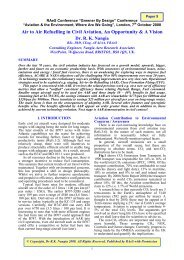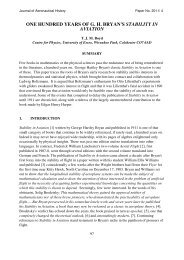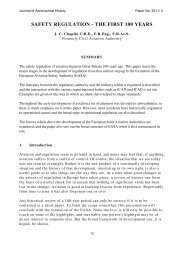TARVIEW Lethality Modelling and Warhead Concepting
TARVIEW Lethality Modelling and Warhead Concepting
TARVIEW Lethality Modelling and Warhead Concepting
You also want an ePaper? Increase the reach of your titles
YUMPU automatically turns print PDFs into web optimized ePapers that Google loves.
The B of the Bang:<br />
<strong>TARVIEW</strong> <strong>Lethality</strong> <strong>Modelling</strong> <strong>and</strong><br />
<strong>Warhead</strong> <strong>Concepting</strong><br />
Dominic Černis<br />
Senior Consultant<br />
15 th November 2012
Contents<br />
Where?<br />
Hi History t<br />
How<br />
What<br />
Video<br />
Why<br />
Current Work<br />
Next Steps<br />
Customer View<br />
Questions
Where?<br />
µm<br />
Penetration models<br />
Engineering g g analysis y<br />
FEA<br />
mm m km 1000 km<br />
<strong>Lethality</strong><br />
analysis<br />
War<br />
games
History<br />
TANKILL commercial version of<br />
lethality software developed for<br />
DRA/DERA/Dstl<br />
MAVKILL takes over in the 1990s.<br />
MMultiple lti l AArmoured d VVehicle hi l KILL<br />
MAVKILL still used in modified<br />
form at Dstl Fort Halstead<br />
INTAVAL is used by Dstl Air<br />
Systems. Developed by Huntings /<br />
LM<br />
Dstl Air Systems also asked us to<br />
develop <strong>TARVIEW</strong><br />
Originally started as a target<br />
viewer for MAVKILL<br />
TANKILL<br />
AVKILL<br />
MAVKILL<br />
INTAVAL<br />
<strong>TARVIEW</strong><br />
1980 1985 1990 1995 2000 2005 2010 2015
<strong>TARVIEW</strong><br />
Originally developed for FRAGWAR, MAVKILL, TANKILL target editing <strong>and</strong><br />
viewing – so now has a strong GUI element<br />
Post processing tools were then added<br />
Since then, more functionality has been gradually added:<br />
St Store warheads, h d ttargets t <strong>and</strong> d scenarios i iin relational l ti l ddatabases t b<br />
Larger more complex models<br />
Reads in geometry from TANKILL <strong>and</strong> STL format generated by CAD tools<br />
MModel d l geometry t verification, ifi ti editing diti <strong>and</strong> d simplification i lifi ti <strong>and</strong> d correction ti<br />
Multiple targets<br />
Blast analysis<br />
<strong>Lethality</strong> Analysis from the GUI:<br />
Interactive Mode for quick evaluation<br />
Long Runs for large assessments with thous<strong>and</strong>s of grids<br />
Multiple warheads<br />
Much improved Fault Trees<br />
Fuzing Approximations<br />
Results viewing<br />
Statistical Post Processing
The Geometry Editor<br />
Most CAD tools cannot generate accurate triangulated geometry (often the<br />
shapes are not volumes <strong>and</strong> components overlap each other)<br />
Models often need to be altered or corrected geometrically<br />
The <strong>TARVIEW</strong> editor allows direct manipulation of the models within the same<br />
program
Ray Tracing<br />
Heart of the lethality engine<br />
<strong>TARVIEW</strong> calculates the intersection of shotlines with target components<br />
Key element in why <strong>TARVIEW</strong> is so fast running
Partitioning – 2D
Partitioning – 3D<br />
Indivisible<br />
Partitions
Search trees<br />
Whole<br />
target<br />
Partition 1 Partition 2 Partition 3<br />
Partition 4 Partition 5 Partition 6 Partition 7<br />
Partition 8 Partition 9 Partition 10 Partition 11 Partition 12
Fragmentation Damage<br />
There are many different types of component penetration algorithms:<br />
THOR<br />
ARF<br />
De Marre<br />
DRI<br />
Grabarek<br />
Lambert<br />
Chen <strong>and</strong> Li<br />
Possible to calculate potential penetration, residual velocity, <strong>and</strong> mass loss of<br />
most fragment/plate material combinations<br />
‘Damage’ is assigned using algorithms that define how a component degrades<br />
on being struck
Blast Damage <strong>Modelling</strong><br />
Blast damage is modelled by calculating the Peak Incident Pressure for a mass of TNT<br />
at a distance using the Kingery <strong>and</strong> Bulmash equations<br />
EEach h component t can have h bl blast t sensitive iti polyhedrons l h d<br />
Polyhedrons are sensitive to blast or fragments, or both or neither<br />
Different polyhedrons in a component can have different blast sensitivity
Shaped Charge<br />
Sh Shaped d charge h ddamage iis assessed d using i PPenSO SO curves<br />
Simple relationship between penetration depth of RHA vs distance from origin<br />
Degraded curve used for subsequent impacts<br />
Penetration<br />
of RHA (mm)<br />
Penetration<br />
of RHA (mm)<br />
RHA<br />
St<strong>and</strong>off (mm) St<strong>and</strong>off (mm)<br />
RRetarded t d d<br />
Penetration<br />
Curves after<br />
strikes
Fault Trees<br />
Fault trees are used to model damage to systems made up of consistent systems<br />
A target can have many different types of fault tree to model different sorts of system<br />
failure<br />
<strong>TARVIEW</strong> can evaluate many fault trees for each warhead burst<br />
The fault trees are run through an algebraic simplifier to:<br />
Make the fault trees much quicker to evaluate<br />
To make the overall meaning of a fault tree easier to check<br />
Fault trees in <strong>TARVIEW</strong> have 4 types of gate:<br />
OR gates g<br />
AND gates<br />
M out of N gates<br />
NOT gates
On with the show…<br />
Video
What is so good about <strong>TARVIEW</strong>?<br />
It’s very quick<br />
What did take months now takes hours<br />
Allows much more to be completed, including<br />
interpretive analysis<br />
Analysis is interactive<br />
It’s easy to use<br />
Modern GUI<br />
Allows verification of the<br />
modelling<br />
Relieves the training g<br />
burden
Trial Comparison / Validation<br />
Comparison of Trial<br />
Fragments to empirical<br />
algorithms<br />
Allows coefficients to be<br />
refined<br />
Shows sensitivity of<br />
algorithms to small<br />
changes<br />
Most of the time the<br />
algorithms broadly<br />
agree....
Trial Comparison / Validation<br />
... Some of the time they<br />
don’t<br />
Some algorithms ‘tuned’<br />
to certain materials<br />
Penetration limit difficult<br />
to model<br />
Informed user required in<br />
all cases
<strong>Warhead</strong> <strong>Concepting</strong><br />
Natural fragmentation<br />
Shaped charge<br />
Many fragments of lower mass<br />
Natural fragmentation<br />
Heavily populated<br />
Preformed <strong>and</strong> natural fragmentation<br />
Shaped charge
Current work<br />
Blast Shadowing Remainder of target exposed to blast<br />
Allows partial shielding of targets by objects<br />
Projectile fired<br />
‘Cookie cutter’ of shield taken out of the target<br />
Blast acts upon what is left<br />
Very complicated geometric problem<br />
Each target needs to be distinct<br />
Projectile penetration<br />
plus l resulting lti BAD cloud<br />
l d<br />
Behind Armour Debris<br />
Shielding<br />
object j<br />
Calculation of spall numbers<br />
Momentum based approximation of velocity<br />
Spall mass distributions<br />
Spall debris acts on other components<br />
Re-use existing algorithms
Next Steps<br />
PJHQ<br />
‘quick start’ user interface<br />
Battle Damage Assessment<br />
Collateral Damage<br />
Take advantage of NOT gates<br />
Efficiency enhancements for blast<br />
Blast relatively y immature compared p to fragmentation g<br />
Plenty of scope to make more efficient in a similar way
Dstl use of <strong>TARVIEW</strong><br />
Jonathan Burnage<br />
Acting g Team Leader, Strike Weapons p Advice Team<br />
Weapons Group, AWSD
<strong>TARVIEW</strong> use across the CADMID cycle<br />
Concept Assessment Demonstrate Manufacture In-service Disposal<br />
• SPEAR Green Box • warhead SPEAR Cap 3 – 100B • SPEAR GFX for Cap 2 Block 1 dive angle • Used by Air Warfare Centre<br />
assessment with MBDA MBDA in support of warhead optimisation<br />
• Multi-role Meteor lethality development<br />
• Dstl support to Air Warfare Centre<br />
y<br />
• SPEAR Cap 2 Block 1 warhead<br />
tactics development<br />
assessment • SPEAR Cap 2 Block 1 MG COEIAassessment<br />
• Tornado GR4 gun ammunition<br />
• SPEAR Cap 2 Block 2 <strong>and</strong> Cap • Fireshadow 3 IG<br />
•GFX Support to PWIV acceptance trials assessment<br />
COEIAs<br />
• FCAC (now Joint Fires) • force Support mix to PWIV Op Eval trials • Reachback – Op ELLAMY<br />
• SPEAR Cap p 2 Block 3 requirements q analysis<br />
definition<br />
• Support to DMS Brimstone • Storm Shadow<br />
• Air to Ground acceptance trials<br />
• Brimstone UOR requirements<br />
• PWIV<br />
definition • Ground to • Ground Support to DMS Brimstone Op Eval<br />
• DMS Brimstone<br />
• Support to NEC-IW Guidance • JSF gunpod assessment trials<br />
Support to NEC IW Guidance<br />
Integrated Fuzing assessment • JSF PWIV by accuracy requirement<br />
MBDA <strong>and</strong> Thales<br />
• Typhoon AESA PWIV accuracy<br />
• Scud Vulnerability assessmentsrequirement<br />
• SPEAR Cap 5 lethality requirements<br />
definition<br />
• JCA decision points<br />
• Typhoon FCP<br />
© Crown Copyright Dstl 2012<br />
<strong>Modelling</strong> activities<br />
Dstl is part of the<br />
Ministry of Defence
Essential characteristics<br />
• Speed<br />
• Ease of use<br />
• Visualisation of lethal effects<br />
• Integrated approach – powerful tool<br />
• Enables Dstl to focus on technical consultancy<br />
© Crown Copyright Dstl 2012<br />
Dstl is part of the<br />
Ministry of Defence
Future developments<br />
• Further V&V<br />
• PJHQ version for BDA<br />
• GUI update<br />
© Crown Copyright Dstl 2012<br />
Dstl is part of the<br />
Ministry of Defence
Predicting lethality<br />
© Crown Copyright Dstl 2012<br />
Dstl is part of the<br />
Ministry of Defence
Support to Operations / Validation<br />
© Crown Copyright Dstl 2012<br />
Dstl is part of the<br />
Ministry of Defence



